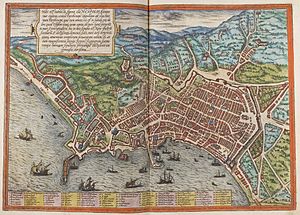Siege of Naples (1528) facts for kids
Quick facts for kids Siege of Naples |
|||||||
|---|---|---|---|---|---|---|---|
| Part of the War of the League of Cognac | |||||||
 1572 map of Naples |
|||||||
|
|||||||
| Belligerents | |||||||
| Commanders and leaders | |||||||
| Strength | |||||||
| 3,000 in the Black Bands | |||||||
The Siege of Naples was a major event in 1528. It happened during a big conflict called the War of the League of Cognac. During a siege, an army surrounds a city to try and take control of it. In this case, the French army tried to capture the Italian city of Naples.
Contents
Key Events of the Siege
Starting the Siege
In April 1528, the French army began its attack on Naples. Their leader was Odet de Foix. He set up his soldiers around the city. At the same time, a naval blockade was put in place. This means ships blocked the port so no supplies could get in or out. Filippino Doria, a skilled naval commander, led this blockade.
The main French camp was on a hill. This hill is now known as Poggioreale. Back then, it was sometimes called after de Foix's Italian nickname, "Lo Trecco."
Early Battles and Leaders
Towards the end of April, a battle took place at sea. Naples' governor, Hugo of Moncada, tried to break through the naval blockade. He wanted to reach the Gulf of Salerno. However, his attempt failed. He was killed by two soldiers using arquebuses, which were early types of guns. His body was thrown into the sea.
During this fight, Alfonso III d'Avalos was captured. He later played an important role. He helped convince Doria to switch sides during the siege. After Moncada's death, Charles V, Holy Roman Emperor chose Philibert of Chalon to be the new governor of Naples.
Losses and Changing Sides
On May 22, a group of soldiers known as the Black Bands faced an ambush. Their leader, Orazio di Giampaolo Baglioni, was killed by a pike near the river Sebeto.
A big change happened on July 4. Filippino Doria stopped the naval blockade. This was because Genoa, Doria's home city, decided to switch its loyalty. Genoa joined the side of the Holy Roman Empire. In return, Genoa gained control over Savoy.
Disease and Retreat
In the summer of 1528, de Foix tried a new tactic. He destroyed the Bolla Aqueduct. This was a water system that supplied Naples. His goal was to cut off the city's water and starve its defenders.
However, this plan had an unexpected and terrible consequence. Destroying the aqueduct turned the surrounding land into swamps. Combined with the hot summer weather, this caused a deadly sickness to spread among the French soldiers. Many soldiers died from this epidemic.
French commander Odet de Foix himself died from the illness on August 15. Command of the French forces then went to Louis, Count of Vaudémont. Sadly, he also died of the same illness just a few days later. The command then passed to Marquis Michele Antonio di Saluzzo.
The French army finally gave up the siege at the end of August. They tried to retreat to Aversa. But an Imperial force intercepted them. During this retreat, Charles of Navarre was captured. The famous military engineer Pietro Navarro was also taken prisoner. Navarro was held in Castel Nuovo. He was killed there later that month.
See also
 In Spanish: Asedio de Nápoles (1528) para niños
In Spanish: Asedio de Nápoles (1528) para niños

